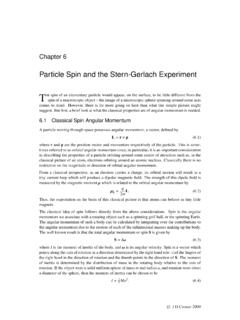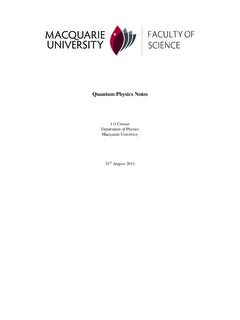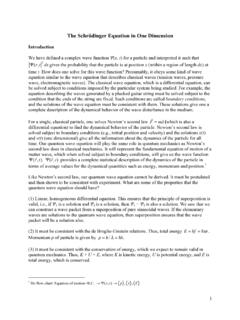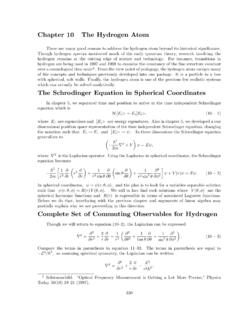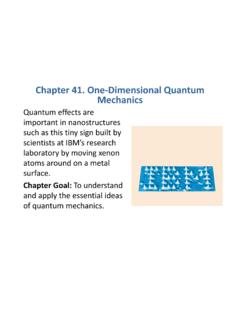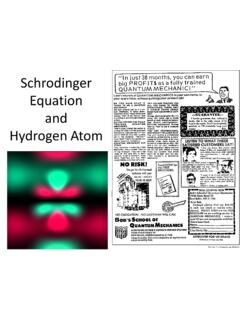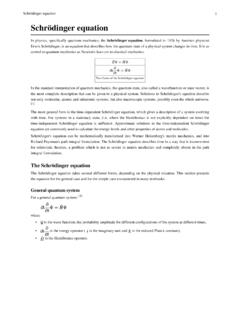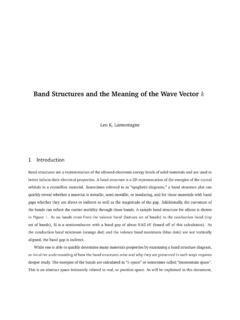Transcription of Time Evolution in Quantum Mechanics
1 Chapter 15 Time Evolution in Quantum MechanicsPhysicalsystems are, in general, dynamical, they evolve in time. The dynamics of classicalmechanical systems are described by Newton s laws of motion, while the dynamics of theclassical electromagnetic field is determined by Maxwell s equations . Either Newton s equationsor Maxwell s equations constitute laws of physics whose form is particular to the kind of systemthat is being described, though some unification is provided in terms of Hamilton s principle, auniversal way of stating the laws of classical dynamics. What we require is a means by which thedynamical properties of Quantum systems can be described, given the state| (0) of a quantumsystem at some initial timet=0, what is required is a physical law that tells us what the state willbe at some other timet, a Quantum law of Evolution .
2 Given that a state vector is a repositoryof the information known about a system, what is required is a general physical law that tells ushow this information evolves in time in response to the particular physical circumstances that thesystem of interest finds itself in. It is to be expected that the details of this law will vary fromsystem to system, but it turns out that the law of Evolution can be written in a way that holds trueforallphysical systems, in some sense similar to the way that Hamilton s principle provides a wayof stating classical dynamical laws in one compact form. Of course, the Quantum law of evolutionis Schr odinger s StatesThe idea of stationary states was first introduced by Bohr as a name given to those states ofa hydrogen atom for which the orbits that the electron occupied were stable, the electronremained in the same orbital state for all time, in contrast to the classical physics prediction thatno orbiting electron could remain in orbit forever: it would always radiate away its energy andspiral into the proton.
3 Although Bohr s original concept is now no longer appropriate, the notionof a stationary state remains a valid one. It is a term that is now used to identify those states ofa Quantum system that do not change in time. This is not to say that a stationary state is one forwhich nothing happens there is still a rich collection of dynamical physics to be associated withsuch a state but a stationary state turns out to be one for which the probabilities of outcomes ofa measurement of any property of the system is the same no matter at what time the measurementis made. Our aim initial aim here is to try to learn what properties the state vector representing astationary state might starting point is to let| (0) be the initial state of the system, and| (t) be the state at someother timet.
4 As this state vector at timetis supposed to represent the system in the same physicalstate, the most that these two states can differ by is a multiplicative factor,u(t) say, | (t) =u(t)| (0) .( )c J D Cresser 2009 Chapter 15 Time Evolution in Quantum Mechanics200 Since we would expect that if the initial state| (0) is normalized to unity, then so would the state| (t) , we can write (t)| (t) =|u(t)|2 (0)| (0) ( )and hence|u(t)|2=1( )so we must conclude thatu(t)=e i (t)( )where (t) is an as yet unknown time dependent phase. Thus we can write| (t) =e i (t)| (0) .( )This result is very general, and perhaps not all that surprising, but it becomes more revealing if wefocus on an important special case, that in which the system is assumed to be isolated that ithas no interaction with any other system the dynamics of the system are determined solely byits own internal interactions.
5 What this means is that if, for such a system, we were initially toprepare the system in some state and allow it to evolve for, say, ten minutes, it should not matterwhen this initial time might be. If we start the experiment at noon and allow it to run for tenminutes, or if we started it at midnight and allow it to run for ten minutes, the state of the systemafter the ten minutes has elapsed should be the same in either case, simply because the system isisolated: the way it behaves cannot be affected by anything external. In contrast, if the systemwereopen, not isolated, then there is the prospect of time dependent external influences actingon the system an externally produced laser pulse fired at an atom so the Evolution of thestate of the atom would differ depending on the starting time.
6 In such a situation the system mightnot have any stationary states at all as it is always potentially being forced to change because ofthese external all this amounts to as that, for an isolated system, we can chose the initial time to be anyarbitrary timet0, and the Evolution of| (t0) up to the timetwould be given by| (t) =e i (t t0)| (t0) ( ) what matters is how long the system evolves for, not what we choose as our starting we now consider the Evolution of the system in a stationary state over a time interval (t,t ), thenwe have| (t ) =e i (t t)| (t) =e i (t t)e i (t t0)| (t0) ( )but over the interval (t0,t ) we have| (t ) =e i (t t0)| (0) ( )so by comparing the last two equations we find thate i (t t0)=e i (t t)e i (t t0)( )or (t t0)= (t t)+ (t t0),( )an equation for with the solution (t)= t( )where is a constant.
7 Thus we can conclude that| (t) =e i t| (0) ( )which is the required expression for the Evolution in time of a stationary state of an isolated J D Cresser 2009 Chapter 15 Time Evolution in Quantum Schr odinger Equation a Derivation .The expression Eq. ( ) involves a quantity , a real number with the units of (time) 1, ithas the units of angular frequency. In order to determine the physical meaning to be given to thisquantity, we can consider this expression in the particular case of a free particle of energyEandmomentump, for which the wave function is given by (x,t)=Aeikxe i t( )where, according to the de Broglie-Bohr relations,E=! andp=!k. In this case, we see that is directly related to the energy of the particle.
8 This is a relationship that we will assume appliesto any physical system, so that we will rewrite Eq. ( ) as| (t) =e iEt/!| (0) ( )and further identify the stationary state| (0) as being an eigenstate of the energy observable Hfor the system, otherwise known as the now make an inductive leap, and identify a stationary state ofanyphysical system as being aneigenstate of the Hamiltonian of the system, with the associated eigenvalue being the energy to beassociated with the stationary state.|E(t) =e iEt/!|E ( )with H|E =E|E ( )from which we get H|E(t) =E|E(t) .( )If we differentiate Eq. ( ) we findi!d|E(t) dt=E|E(t) = H|E(t) ( )which we can now use to obtain the equation satisfied by an arbitrary state vector| (t).
9 First,since the eigenstates of H, call them{|E1 ,|E2 ,..,|EN }, form a complete set of basis states, wecan write for the initial state| (0) =N n=1|En En| (0) .( )The time evolved version is then| (t) =N n=1e iEnt/!|En En| (0) ( )which, on differentiating, becomesi!d| (t) dt=i!N n=1 Ene iEnt/!|En En| (t) =N n=1 He iEnt/!|En En| (t) = HN n=1e iEnt/!|En En| (t) = H| (t) ( )c J D Cresser 2009 Chapter 15 Time Evolution in Quantum Mechanics202so we have H| (t) =i!d| (t) dt( )which is the celebrated Schr odinger equation in vector the solution of this equation is the essential task in determining the dynamical prop-erties of a Quantum system. If the eigenvectors and eigenvalues of the Hamiltonian can be readilydetermined, the solution can be written down directly, it is just| (t) = ne iEnt/!
10 |En En| (0) .( )However, it is not necessary to follow this procedure, at least explicitly, as there are in generalmany ways to solving the equations . In any case, the process of obtaining the eigenvalues andeigenvectors is often very difficult, if not impossible, for any but a small handful of problems, soapproximate techniques have to be information about the Hamiltonian is available as its components with respect to someset of basis vectors, the Hamiltonian is given as a matrix. In the next Section, an example ofsolving the Schr odinger equation when the Hamiltonian matrix is the Schr odinger equation: An illustrative exampleThe aim here is to present an illustrative solution of the Schr odinger equation using as the examplethe O 2ion studied in the preceding Chapter.


